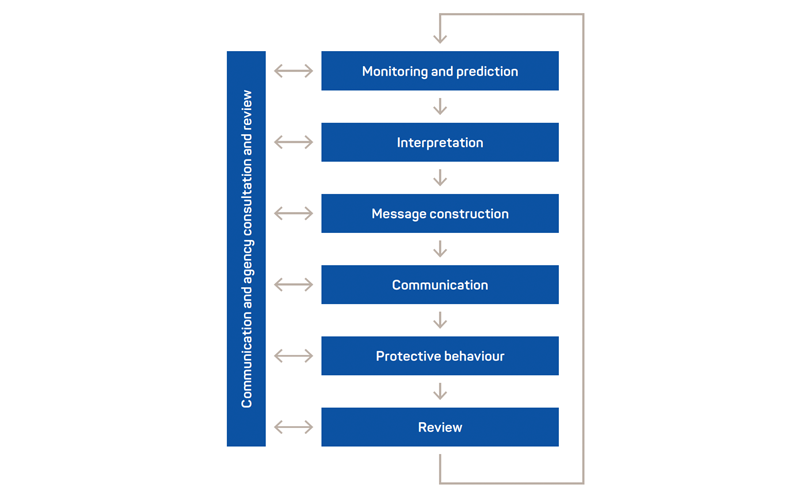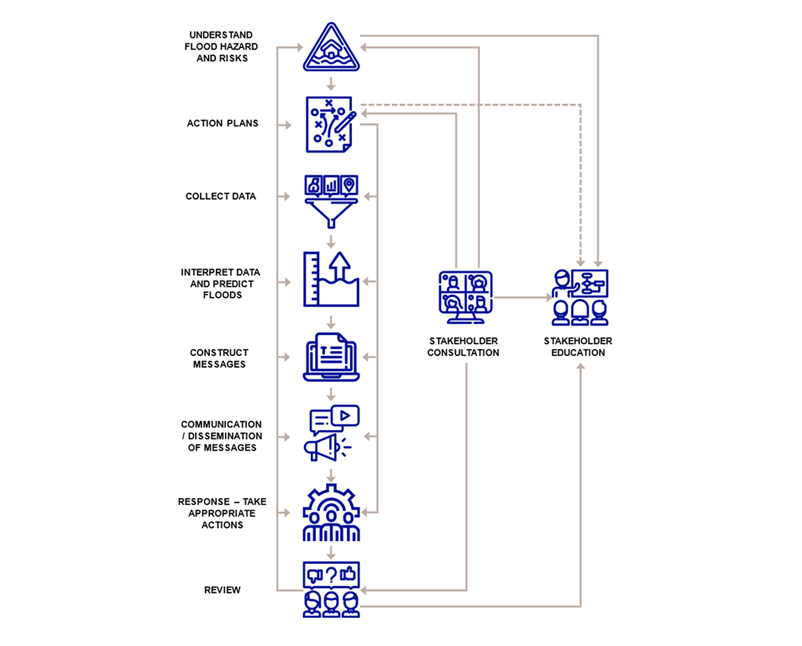Introduction
The Total Flood Warning System concept is promoted by the Australian Government and is widely used in the design of Australia’s early flood warning systems. The Total Flood Warning System concept is technically robust in comparison with international flood warning system frameworks. However, it is not as ‘total’ as it might be. This paper looks at six other components identified that make the system holistic and more effective.
Early warning systems are designed to save lives and protect property where possible. According to Mileti and Sorensen (1990, p.2):
A warning system is a means of getting information about an impending emergency, communicating that information to those who need it, and facilitating good decisions and timely response by people in danger.
In Australia, flood early warning systems are an important part of the flood risk management process promoted by the Australian Government and implemented by the states and territories, largely via local government and, in Victoria, by catchment management authorities.
Guidance provided in the Managing the floodplain: A Guide to Best Practice in Flood Risk Management in Australia (Australian Institute for Disaster Resilience 2017, p.61), shows that early warning systems are a flood response modification option and are one of ‘a range of measures to reduce residual flood risk at a community scale’. In comparison with other flood risk management options, flood warning is assessed in this national guide as having a ‘medium’ capacity to address safety risks and a ‘low’ capacity to address property damage risks, both in existing and future urban developed areas (Australian Institute for Disaster Resilience 2017, p.46).
The Australian Government has provided guidance to assess and design robust flood warning systems. It introduced the concept of the ‘total flood warning system’ (TFWS) to describe the full range of elements that must be developed if flood warning services are to be provided effectively.
The lead document for the development of the TFWS in Australia is Manual 21 – Flood Warning (Attorney-General’s Department 2009). As shown in Figure 1 and according to Manual 21, at its simplest, the TFWS consists of six components.
- Prediction - detecting changes in the environment that lead to flooding and predicting river levels during the flood.
- Interpretation - identifying in advance the impacts of the predicted flood levels on communities at risk.
- Message construction - devising the content of the message that will warn people of impending flooding.
- Communication - disseminating warning information in a timely fashion to people and organisations likely to be affected by the flood.
- Response - generating appropriate and timely actions from the threatened community and from the agencies involved.
- Review - examining the various aspects of the system with a view to improving its performance.
Manual 21 (Attorney-General’s Department 2009, p.7) stresses that for the TFWS to ‘work effectively, these components must all be present and they must be integrated rather than operating in isolation from each other’.
Cawood, Keys and Wright (2018) describe the genesis of the TFWS concept emanating from a series of workshops held after severe flooding in parts of Australia in 1990. The workshop participants included representatives from the Australian Bureau of Meteorology and forecasting and emergency management professionals. The document resulting from the workshops, Flood Warning: an Australian Guide, was published in 1995 (Australian Emergency Management Institute 1995). This guide was updated through revisions to Manual 21 including the TFWS concept.
The TFWS concept is now widely used in flood risk management in Australia. TFWS is invariably a requirement in the assessment and design of flood early warning systems by local councils and catchment management authorities as well as by the consultants they commission. The National Arrangements for Flood Forecasting and Warning (Bureau of Meteorology 2018, p.9) states that ‘Flood warning systems in Australia are designed using the concept of the Total Flood Warning System’.
The Total Warning System concept has now been recommended by the Australian Government for all hazards (Australian Institute for Disaster Resilience 2018). Further TFWS advice as an update of Manual 21 will be provided in a companion document to Flood Emergency Planning for Disaster Resilience (Australian Institute for Disaster Resilience 2020).
A review of the TFWS concept in relation to Australian and international research was undertaken by the author to ascertain its ongoing value in guiding the design, implementation and evaluation of flood early warning systems. In particular, the review assessed the holistic ideal of the TFWS and the veracity of the six identified TFWS components (Attorney-General’s Department 2009).

Figure 1: The components of the Total Flood Warning System (Attorney-General’s Department 2009, p.6).
Technical legitimacy
The TFWS aligns well with internationally promoted early warning system frameworks. For example, according to the International Strategy for Disaster Reduction (2006), there are four separate but interlinked elements of effective people-centred early warning systems:
- Risk knowledge.
- Technical monitoring and warning service.
- Dissemination and communication.
- Response capability.
‘Risk knowledge’ aligns with ‘Interpretation’ in the TFWS. ‘Technical monitoring and warning service’ aligns with ‘Prediction’, ‘Dissemination and communication’ aligns with the components of ‘Message construction’ and ‘Communication’ and ‘Response capability’ aligns with ‘Response’. The TFWS provides an extra ‘Review’ component to those by the International Strategy for Disaster Reduction (2006).
Holistic ideal
The TFWS has been criticised for not being as ‘total’ as it could be. For example, as shown in Figure 2, Molino and co-authors (2011) argued for an extension of the TFWS to include six additional components:
- understanding the flood risk
- emergency management planning
- community flood education
- data collection including location and use of rain gauges and river level gauges
- community participation
- integration of the TFWS components.
The additional components have merit. According to Molino and colleagues (2011), understanding the flood risk not only relates to flood risk mapping and modelling as included in the existing ‘Interpretation’ component of the TFWS but also to pre-flood risk communication (e.g. to residents and businesses).
Flood warning is an integral part of emergency management planning. All jurisdictions have emergency legislation, policies, plans and governance that should include provision for effective flood warning services. For example, in Victoria all local councils with flood risk are required to have a Municipal Flood Emergency Plan, which includes details of emergency agency actions related to triggers such as stream gauge heights.
Community flood education and engagement helps people learn how to prepare for and respond to floods (including to flood warnings) and also recover from them. The prime outcome is public safety, with a secondary outcome being protection of property (Dufty 2020).

Figure 2: Extended Total Flood Warning System components (Molino et al. 2011).
For the effective development of a flood warning system, preparedness community education content should include providing learning about flood risk, identifying flood triggers (e.g. river heights), what people should do to ensure the safety of themselves and others if possible (e.g. their family, neighbours, vulnerable people in the community) and what people should do to protect their property, companion animals and livestock (if applicable). People in flood-prone areas should also be aware of the possible flood warning lead times to enable them to carry out safe responses.
An essential basic input to a total flood warning system is rain and river data. The existing river level gauges (with telemetry) and rainfall gauges (daily and sub-daily) available to a community should be assessed prior to the design of a local flood warning system.
There is a growing body of evidence showing that community participation is critical in the development of effective early warning systems. For example, the United Nations International Strategy for Disaster Reduction provides a checklist for developing early warning systems (International Strategy for Disaster Reduction 2006, p.4). It states that communities:
…should be actively involved in all aspects of the establishment and operation of early warning systems; be aware of the hazards and potential impacts to which they are exposed; and be able to take actions to minimize the threat of loss or damage.
Manual 21 stresses the need for integration of the components of the TFWS.
For a flood warning system to work effectively, these components must all be present and they must be integrated rather than operating in isolation from each other. The view that any one component of the system represents all of it, or is an end in itself, impairs the system’s effectiveness.
(Attorney-General’s Department 2009, p.7)
Molino and colleagues (2011) note that:
…each of these warning system parts can work well or can work poorly or at worst, not work at all. The overall effectiveness of the warning can only be as strong as the weakest link in the chain and, unlike a real chain, errors or weaknesses can accumulate as they are passed along the chain. For example, poor data plus poor interpretation can be worse than either poor data or poor interpretation.
Thus, the integration of total flood warning system components should be a separate component to ensure that linkages are strong and working effectively.
‘Review’ is a critical total flood warning system component as it leads to warning system improvements before and after a flood. Manual 21 (Attorney-General’s Department 2009, p.71) provides a list of possible performance indicators that can be used as a basis for review. Other guidance to review has been provided (e.g. Parker & Neil 1990). It is important that flood early warning systems are reviewed regularly to ensure all components are working effectively.
It should be noted that recent Australian Government guidance on total warning systems has embraced some of the suggested additional total flood warning system components. For example, Handbook 16 – Public Information and Warnings (Australian Institute for Disaster Resilience 2018, p.11), acknowledges prior community education and engagement about warning as an important part of a Total Warning System. As part of emergency management planning, the need to set ‘organisational capability, systems and arrangements in place to warn effectively’ is also identified.
Conclusion
The TFWS concept promoted by the Australian Government is entrenched in the Australian flood sector. It compares favourably to international flood warning frameworks identifying an additional critical ‘Review’ component.
However, the TFWS should be extended to include at least six other components, including emergency management planning and community flood education that require actions prior to flood events.


